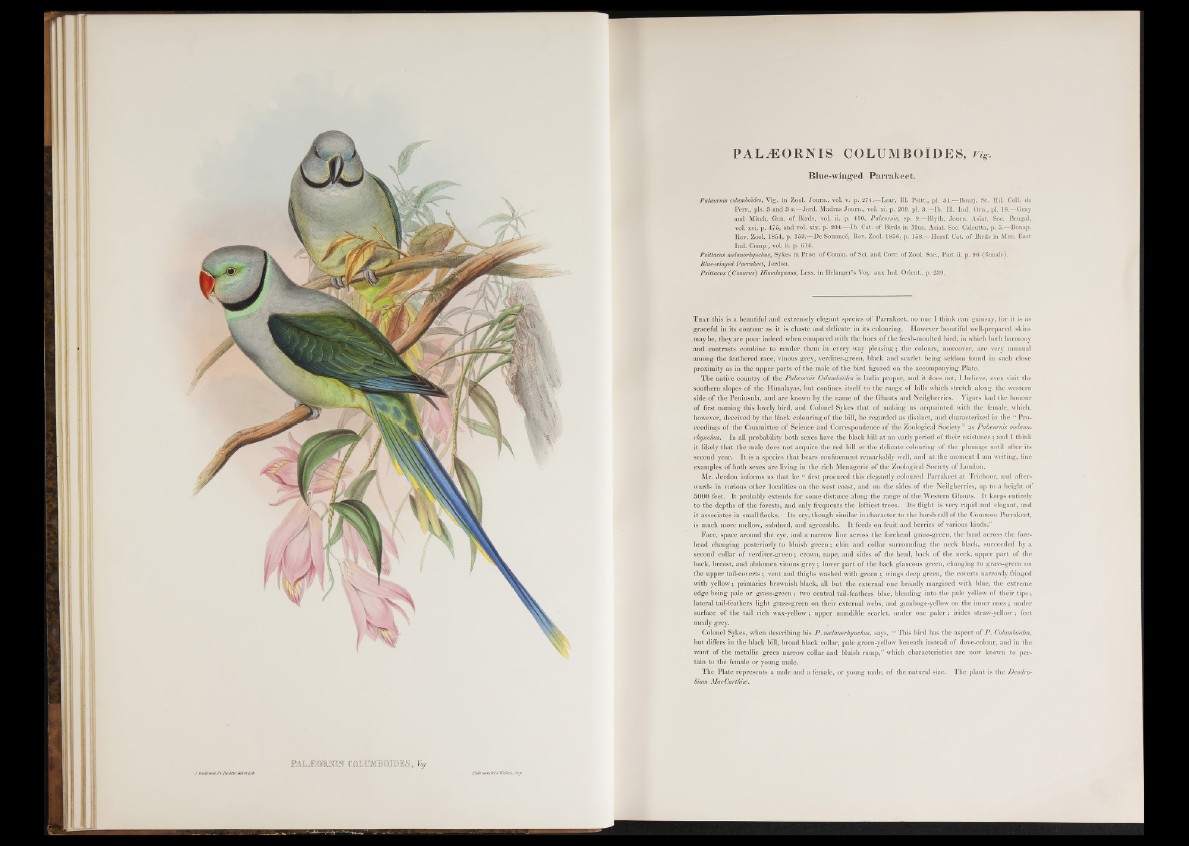
PALCEORNIS COLUMBOIDES, rig.
Blue-winced Parrakeet.
Palceornis columboides, Vig. in Zool. Journ., vol. v. p. 274.—Lear, 111. Psitt., pi. 31.—Bouij. St. Hil. Coll. de
Perr., pis. 3 and 3 a.— Jerd. Madras Journ., vol. m p. 209. pi. 3 .—lb. 111. Ind. Om., pi. 18.—Gray
and Mitch. Gen. o f Birds, vol. ii. p. 410, Palaornis, sp. 9.—Blyth, Journ. Asiat. Soc. Bengal,
vol. xvi. p. 475, and vol. xix. p. 204.— lb . Cat. o f Birds in Mus. Asiat. Soc. Calcutta, p. 5.— Bonap.
Rev. Zool. 1854, p. 152.—De Souance, Rev. Zool. 1856, p. 158.— Horsf. Cat. of Birds in Mus. East
Ind. Comp-, vol. ii. p. 614.
Psittacus melanorhynchus, Sykes in Proc. of Comm, o f Sci. and Corr. of Zool. Soc., Part ii. p. 96 (female).
Blue-winged Parrakeet, Jerdon.
Psittacus (Conurus) Himalayanus, Less, in Belanger’s Voy. aux Ind. Orient., p. 239.
T hat this is a beautiful and extremely elegant species o f Parrakeet, no one I think can gainsay, for it is as
graceful in its contour as it is chaste and delicate in its colouring. However beautiful well-prepared skins
may be, they are poor indeed when compared with the hues o f the fresh-moulted bird, in which both harmony
and contrasts combine to render them in every way p le a sin g ; the colours, moreover, are very unusual
among the feathered race, vinous grey, verditer-green, black and scarlet being seldom found in such close
proximity as in the upper parts o f the male o f the bird figured on the accompanying Plate.
The native country o f the Palceornis Columboides is India proper, and it does not, I believe, even visit the
southern slopes o f the Himalayas, but confines itse lf to the range o f hills which stretch along the western
side o f the Peninsula, and are known by the name o f the Ghauts and Neilgherries. Vigors had the honour
o f first naming this lovely bird, and Colonel Sykes that o f making us acquainted with the female, which,
however, deceived by the black colouring o f the bill, he regarded as distinct, and characterized in the “ Proceedings
o f the Committee o f Science and Correspondence o f the Zoological Society ” as Palceornis melanorhynchus.
In all probability both sexes have the black bill at an early period o f their ex istenc e; and I think
it likely that the male does not acquire the red bill or the delicate colouring o f the plumage until after its
second year. It is a species that bears confinement remarkably well, and at the moment I am writing, fine
examples o f both sexes are living in the rich Menagerie o f the Zoological Society o f London.
Mr. Jerdon informs us that he “ first procured this elegantly coloured Parrakeet at Trichoor, and afterwards
in various other localities on the west coast, and on the sides o f the Neilgherries, up to a height o f
50 0 0 feet. It probably extends for some distance along the range o f the Western Ghauts. It keeps entirely
to the depths o f the forests, and only frequents the loftiest trees. Its flight is very rapid and elegant, and
it associates in small flocks. Its cry, though similar in character to the harsh call o f the Common Parrakeet,
is much more mellow, subdued, and agreeable. It feeds on fruit and berries o f various kinds.”
Face, space around the eye, and a narrow line across the forehead grass-green, the band across the forehead
changing posteriorly to bluish g r e en ; chin and collar surrounding the neck black, succeeded by a
second collar o f verditer-green; crown, nape, and sides o f the head, back o f the neck, upper part o f the
back, breast, and abdomen vinous g r e y ; lower part o f the back glaucous green, changing to grass-green on
the upper tail-coverts; vent and thighs washed with green ; wings deep green, the coverts narrowly fringed
with yellow; primaries brownish black, all but the external one broadly margined with blue, the extreme
edge being pale or grass-green; two central tail-feathers blue, blending into the pale yellow o f their tip s ;
lateral tail-feathers light grass-green on their external webs, and gamboge-yellow on the inner ones ; under
surface o f the tail rich wax-yellow; upper mandible scarlet, under one p a le r ; irides straw-yellow; feet
mealy grey.
Colonel Sykes, when describing his P . melanorhynchus, says, “ This bird has the aspect o f P . Columboides,
but differs in the black bill, broad black collar, pale green-yellow beneath instead o f dove-colour, and in the
want o f the metallic green narrow collar and bluish rump,” which characteristics are now known to pertain
to the female or young male.
The Plate represents a male and a female, or young male, o f the natural size. The plant is the Dendro-
bium MacCarthice.